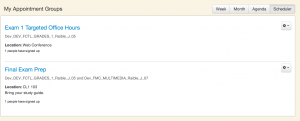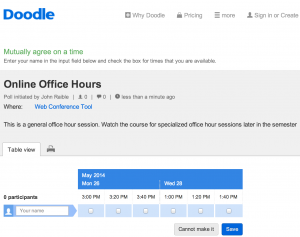Description
In a distance learning environment, Moore (1989) suggests there are 3 different interaction types: student to student, student to instructor, and student to content. Given various variables such as class size, student location, student needs, teaching load, and content complexity, managing student to instructor interaction can be a difficult and time consuming process. How can an instructor manage student interactions more efficiently?
Why sign up sheets?
According to Wang, Dziuban, Cook, and Moskal (2009), one of the most effective predictors for student satisfaction is organization of the course. Using signup sheet as an organizational tool to manage student to instructor interaction can be more efficient and increase student satisfaction.
Sign up sheets allow the instructor to set a consistent schedule for office hours or other virtual meetings. In addition, the instructor can set how many students can attend each session.
Students may not take full advantage but it’s the perception that you are available if they need you that increases the feeling of inclusion.
When do I use it?
Using a signup sheet, regardless of the technology, should be used starting in the first week of class. This provides the students the opportunity for familiarity with how the tool will be used throughout the course.
Dr. Carolyn Massiah of the University of Central Florida utilizes this strategy to offer face to face student meetings. Due to the size of her course, 1500 students, she placed a restriction on how many students could sign up along with the topics for each session.
How do I use it?
When determining what technology to use, ask yourself :
- Do you want students to see who has signed up for the same timeslot?
- Do I want a restriction on how many timeslots a student can sign up for?
- Do students have to create an account with a third party service?
- Am I collecting sensitive student information?
There are several technologies outside of a learning management system (LMS) available to use as sign up sheets:
Inside of an LMS, Instructure’s Canvas offers a scheduler tool.
This strategy can be used in isolation or in sequence with the following strategies to more effectively engage with your students outside of class:
- Create a Personalized Student Intervention
- Reach More Students with Targeted Office Hours
- Managing Student Interaction with Sign Up Sheets
- Use Web Conferencing Tools for Office Hours
Link to example artifact(s)

Instructor Testimony
- Instructor: Dr. Carolyn Massiah
- Course Title: MAR3023 Marketing
- Description of MAR3023 by Dr. Massiah
- Student sign up sheet impact by Dr. Massiah
Link to scholarly reference(s)
Moore, M. G. (1989). Three types of interaction. The American Journal of Distance Education, 3(2), 1–6.
Wang, M. C., Dziuban, C. D., Cook, I. J., & Moskal, P. D. (2009). [Dr. Fox Rocks: Using Data-mining Techniques to Examine Student Ratings of Instruction]. In M. C. Shelley II, L. D. Yore, & B. Hand (Eds.), Quality research in literacy and science education: International perspectives and gold standards. Dordrecht, The Netherlands, Springer, pp383-398.
Citation
Raible, J., Howard, W., Chen, B. & Thompson, K. (2014). Manage student interaction with sign up sheets. In B. Chen & K. Thompson (Eds.), Teaching Online Pedagogical Repository. Orlando, FL: University of Central Florida Center for Distributed Learning. https://topr.online.ucf.edu/managing-student-interaction-with-sign-up-sheets/.
